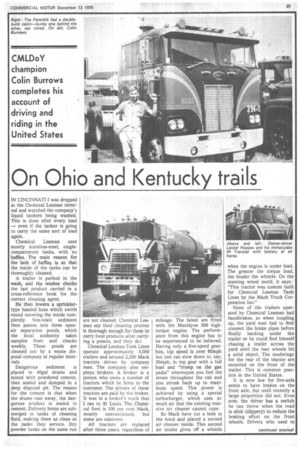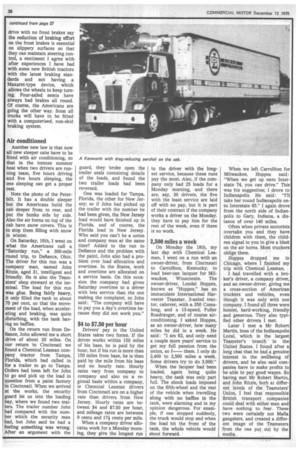On Ohio and Kentucky tra
Page 41

Page 42

If you've noticed an error in this article please click here to report it so we can fix it.
IN CINCINNATI I was dropped at the Chemical Leaman terminal and watched the company's liquid tankers being washed. This is done after every load --even if the tanker is going to carry the same sort of load again.
Chemical Leaman uses mostly stainless-steel, singlecompartment tanks, with no baffles. The main reason for the lack of baffles is so that the inside of the tanks can be thoroughly cleaned.
A trailer is ,parked in the wash, and the washer checks the last product carried in a cross-reference book for the correct cleaning agent.
He then lowers a sprinklertype headed hose which swirls round covering the inside completely. Non-toxic sediment then passes into three openair separation ponds, which the local authority takes samples from and checks weekly. These ponds are cleaned out by •a waste disposal company at regular intervals.
Dangerous sediment is placed in 40gal drums and mixed with powdered cement, then sealed and dumped in a deep disposal pit. The reason for the cement is that when the drums rust away, the dangerous product is sealed in cement. Delivery hoses are submerged in tanks of cleaning fluid, making them as clean as the tanks they service. Dry powder tanks on the same run are not cleaned. Chemical Leaman say their cleaning process is thorough enough for them to carry food products after carrying a poison, and they do?
Chemical Leaman Tank Lines operate approximately 3,000 trailers and around 2,200 Mack tractors driven by company men. The company also employs brokers. A broker is a person who owns a number of tractors which he hires to the customer. The drivers of these tractors are paid by the broker. It was in a broker's truck that I ran to St Louis. The Chemical fleet is 100 per cent Mack, mostly conventionals, but some are cabovers.
All tractors are replaced after three years, regardless of mileage. The latest are fitted with the Maxidyne 300 hightorque engine. The performance from this engine has to be experienced to be believed. Having only a five-speed gearbox, top speed is over 60mph but one can slow down to, say, 30mph, in top gear with a full load and "tromp on the gas pedal" whereupon you feel the strain throughout the cab and you streak back up to maximum speed. This power is achieved by using a special turbocharger, which uses so much air that the existing massive air cleaner cannot cope.
So Mack have cut a hole in the hood and placed a second air cleaner inside. This second air intake gives off a whistle when the engine is under load. The greater the torque load, the louder the whistle. On the steering wheel motif, it says : "This tractor was custom built for Chemical Leaman Tank Lines by the Mack Truck Corporation Inc," None of the trailers operated by Chemical Leaman had handbrakes, so when coupling up, the yard man had to first. connect the brake pipes before finally backing under the trailer or he could find himself.
chasing a trailer across the yard until the rear wheels hit a solid object. The mudwings for the rear of the tractor are mounted on the front of the trailer. This is common practice in the United States.
It is now law for five-axle semis to have brakes on the front axle, but until recently a large proportion did not. Even now, the driver has a switch he can throw when the road is slick (slippery) to reduce the braking effort on the front wheels. Drivers who used to drive with no front brakes say the reduction of braking effort on the front brakes is essential on slippery surfaces so that they can maintain steering control, a sentiment I agree with after experiences I have had with some new British tractors with the latest braking standards and not having a Maxaret-type device, which allows the wheels to keep turn ing. Four-axled semis have always had brakes all round.
Of course, the Americans are going the other way. Soon all trucks will have to be fitted with a computerised. non-skid braking system.
Air conditioned
Another new law is that now all new sleeper cabs have to be fitted with air conditioning, so that in the intense summer heat when two drivers are running team, five hours driving and five hours sleeping, the one sleeping can get a proper rest.
Note the photo of the Peterbilt. It has a double sleeper but the Americans build the cab deeper front to rear, and put the bunks side by side. Also the air horns on top of the cab have snow covers. This is to stop them filling with snow in winter.
On Saturday, 16th, I went on what the Americans call a "Saturday run," a 300-mile round trip, to Defiance, Ohio. The driver for this run was a company man, named John Ritzie, aged 31, intelligent and friendly. He is also the Teamsters' shop steward at the terminal. The load for this run was glue. Being fairly heavy, it only filled the tank to about 70 per cent, so that the movement of the load, when accelerating and braking, was quite disturbing, with the tank having no baffles.
On the return run from Defiance, John allowed me a short drive of about 20 miles. On our return to Cincinnati we found a Chemical Leaman company tractor from Tampa, Florida, which had called in for a trailer to go to Tampa. Orders had been left for John to go and pick up the load in question from a paint factory in Cincinnati. When we arrived at the works, the security guard let us into the loading bay, where we found two trailers. The trailer number John had compared with the number which the security man had, but John said he had a feeling something was wrong. After an argument with the guard, they broke open the trailer seals containing details of the loads, and found the two trailer loads had been reversed.
One was loaded for Tampa, Florida, the other for New Jersey; so if John had picked up the trailer with the number he had been given, the New Jersey load would have finished up in Florida, and of course, the Florida load in New Jersey. Who said you can't be a union and company man at the same time? Added to the run to Defiance and the problem with the paint, John also had a problem over load 'allocation and overtime. In the States, work and overtime are allocated on a service basis. On this occasion the company had given Saturday overtime to a driver with less service than the one making the complaint, so John said : "The company will have to pay you a day's overtime because they did not work you."
$4 to $7.50 per hour
Drivers' pay in the United States takes two forms. If the driver works within 150 miles of his base, he is paid by the hour, but if his run is more than 150 miles from base, he is then paid by the mile from his base and no hourly rate. Hourly rates vary from company to company and also on a regional basis within a company, ie Chemical Leaman drivers from Cincinnati are on a higher rate than drivers from New Jersey. Hourly rates are between $4 and $7.50 per hour, and mileage rates are between 9 cents and 17/ cents per mile.
When a company driver allocates work for a Monday morning, they give the longest run to the driver with the longest service, because these runs pay the most. Also, if the company only had 25 loads for a Monday morning, and •there are, say, 30 drivers, the five with the least service are laid off with no pay, but it is part of their contract if the company works a driver on the Monday. they have to pay him for the rest of the week, even if there is no work.
2,500 miles a week
On Monday the 18th, my last day with Chemical Leaman, I went on a run with an owner-driver, from Cincinnati to Carrollton, Kentucky, to load beer-can lacquer for Milwaukee, Winsconsin. The owner-driver, Lendal Hoppes, known as "Hoopes," has an immaculate International Harvester Transtar, 3-axled tractor, cabover, with a 350 Cumalong, and a 13-speed, Fuller Roadranger, and of course airconditioning. I asked Hoppes, as an owner-driver, how many miles he did in a week. He said : "I am 62, and only need a couple more years' service to get my full pension from the union, so f— them. I only do 2,400 to 2,500 miles a week. Some drivers try to do 3,000."
When the lacquer had been loaded, again being quite heavy, the tank was only part full. The shock loads imposed on the fifth-wheel and the rest of the vehicle when travelling along with no baffles in the tank, were alarming and in my opinion dangerous. For example, if one stopped suddenly, the truck would stop and when the load hit the front of the tank, the whole vehicle would shoot forward. When we left Carrollton for Milwaukee, Hoopes said: "When we get up onto Interstate 74, you can drive." This was his suggestion; 1 drove to Indianapolis. He said : "I'll take her round Indianapolis onto Interstate 65." I again drove from the north side of Indianpolis to Gary, Indiana, a distance of over 140 miles.
Often when private motorists overtake you and they have children with them, the children signal to you to give a blast on the air horns. Most truckers oblige them.
Hoppes dropped me in Chicago, where I finished my trip with Chemical Leaman.
I had travelled with a broker's driver, a company driver, and an owner-driver, giving me a cross-section of American truckers and vehicles, even though it was only with one company. I found all three were honest, hard-working, friendly and generous. They also typified other drivers I met.
Later I met a Mr Robert Martin, boss of the Indianapolis Local, which is the largest Teamster's branch in the United States. I found after a long chat that he had a genuine interest in the wellbeing of drivers, and he also said companies 'have to make profits to be able to pay good wages. So having met Mr Robert Martin, and John Ritzie, both at different levels of the Teamsters' Union, I feel that responsible British transport companies could deal with either man and have nothing to fear. These two were certainly not Mafia gangsters, and created a different image of the Teamsters from the one put out by the media.














































































